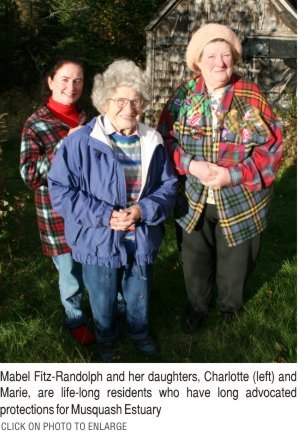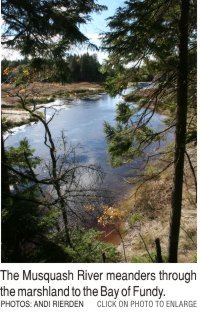
Editor's Notes
Marine protected area a long time coming
Printer Friendly Page
At 92 years old, Fitz-Randolph has been called the heart and soul of Musquash Estuary. A passionate
conservationist and local historian, she has spent much of her time passing along stories about the
region's heritage and watching over the gentle coastal landscape behind her home that continues to
inspire her life.
“I love it here so dearly and so hope to see it preserved in its natural state,” she said referring
to the expansive estuary and the community's efforts to protect it. “I've simply got to live to see
our work finished. That to me would be heaven.”
I am crossing my fingers that Fitz-Randolph will get her wish in the not too distant future. The final
designation of Musquash was anticipated this fall. But then came another time lag. Canada is undergoing
a federal election campaign, which began in late November and will run until January 28 when voters
go to the polls. The election process will likely delay the final designation of Musquash Estuary for
several months.
When it finally does occur, the estuary, skirting Hwy 1 just west of Saint John, will become the
first marine protected area (MPA) in the Bay of Fundy.The system contains 773 hectares [1,700 acres]
of marshland, including the largest salt marsh system in the Bay and supports all habitats found
in the region from cobble and sand beaches and mudflats, to rocky headlands, coastal forests and
islands. Fish, birds and inland wildlife abound here, just as they have for centuries.
Before Fitz-Randolph was born, Musquash bustled with saw and cotton mills, a meat factory and
several hotels. A major forest fire in 1903 burned out many of the farms and few of them were
rebuilt. By the 1920s many of the dykes built by British soldiers who had come to the area after
the American Revolution had washed out with the tides. The rest disappeared when the spring freshet
of 1923 broke through the hydro dam on the Musquash River sending a cascade of water downstream that
engulfed houses, barns, farm animals and bridges. Fitz-Randolph knew the farmer down the road who
died in the flood while trying to move his animals to safety.
Today the marshlands are much more subdued, used mostly by a handful of fishermen, hunters,
birders and canoeists. The com-munity would like to keep it that way. Every August for the past
several years, Fitz-Randolph has joined a group of Musquash MPA supporters on a canoe paddle
seven miles down the Musquash River to the Bay of Fundy.
Musquash's journey from quiet backwater to MPA designation is a remarkable story in itself, with
people like Fitz-Randolph at center stage. The exhaustive grassroots undertaking involved two
levels of government, Ducks Unlimited Canada, the Nature Conservancy of Canada, private landowners,
local universities, industry and countless surveys and studies. The process began in the late-1990s
when the Conservation Council of New Brunswick (CCNB), Conservation Law Foundation and the Island
Institute initiated the Gulf of Maine Estuaries Restoration Project as part of the Restore America's
Estuaries program. For its part, CCNB assessed Bay of Fundy estuaries and identified Musquash as the
only major estuary to dodge development or degradation. In 1998, CCNB with the backing of the Fundy
North Fishermen's Association, the primary users of the estuary, proposed Musquash as a MPA under
Canada's Ocean Act. Through community meetings in a converted one-room school house, chats around
kitchen tables and dozens of other sessions, stakeholders were able to come to a consensus about
what should or should not be permitted.
“There were a lot of things to resolve,” said Maria-Ines Buzeta, a marine biologist with the
Department of Fisheries and Oceans who has worked closely with the community throughout the
designation process. “From the first meeting, we worked from a list of what to allow and what not.”
Their objective, she added, “was to minimize disturbance, damage and destruction, while still
permitting the MPA to contribute to the livelihood of the community.”
In addition to government protections of the estuary, the Nature Conservancy of Canada has acquired
more than 1,000 acres adjacent to the marsh with a goal of securing 3,000 acres. The nearby town of
Lorneville has developed plans for a coastal park, which would encompass three miles of shoreline
bordering the east side of Musquash Estuary and a lighthouse at Musquash Head to use as an
information center.
In June, federal Fisheries Minister Geoff Regan called Musquash, “the last ecologically intact and
highly productive estuary in the Bay of Fundy.” At the time, Regan announced three new MPA's in
eastern Canada, in Prince Edward Island, Newfoundland and Labrador. Before Musquash receives
complete designation, however, the federal government and three provincial government agencies,
which are collectively responsible for the seafloor and zone above the low water mark (the federal
government is responsible for the water and the fish), must work out a management scheme. The
province is supportive of the MPA.
The fact that it is taking so long is a concern to many of Musquash's advocates, who say given the
pressures from LNG proposals, forest practices and other moves to industrialize even the most remote
areas of the region, there is little time to waste in protecting coastal and marine systems. Some of
the original volunteers for the project, supporters point out, have lost hope and quit, or have died.
“We've done all the work. There is no division or dissension,” said David Thompson, CCNB's Fundy
Baykeeper, who was instrumental in coordinating community meetings and moving the project forward.
“If we have to wait eight years for an MPA, what hope is there to protect sensitive marine areas?
We can't keep dragging our feet forever.”
Fitz-Randolph remains determined to see all the hard work and tenacity it took to stay the course,
come to fruition. Two years ago, she said, the then fisheries minister told her Musquash would be
fully designated by her 90th birthday. When I spoke to her in October, she was hoping the
announcement would come by her 92nd birthday just a few days away. Hopes for an announcement around
Christmas-time were dashed by the federal election campaign.
Ever the optimist, she is already looking beyond Musquash. When the designation does happen, she
said, “Oh, happy day. It will be the Bay of
Fundy's first marine protected area, but hopefully not its last.”
©
2005 The Gulf of Maine Times
 MABEL FITZ-RANDOLPH has spent her life living along the upper reaches of Musquash Estuary in coastal
southern New Brunswick. Her home, a simple yellow, wood-framed house surrounded by flowers and woods,
overlooks the wind swept salt marshes and dark spruce forests where her community survived for
generations as farmers, loggers and fishers. Together, she and her husband, the descendant of British
Loyalists, farmed and lived off the land, raised three children and saw their neighbors through
troubled times. “My husband and I made a respectable living; shipped our produce all the way to
Boston,” she recalled to me when I visited her this fall. “I washed our clothes with a scrub board
and made my own butter. Electricity didn't get here until the early 60s.”
MABEL FITZ-RANDOLPH has spent her life living along the upper reaches of Musquash Estuary in coastal
southern New Brunswick. Her home, a simple yellow, wood-framed house surrounded by flowers and woods,
overlooks the wind swept salt marshes and dark spruce forests where her community survived for
generations as farmers, loggers and fishers. Together, she and her husband, the descendant of British
Loyalists, farmed and lived off the land, raised three children and saw their neighbors through
troubled times. “My husband and I made a respectable living; shipped our produce all the way to
Boston,” she recalled to me when I visited her this fall. “I washed our clothes with a scrub board
and made my own butter. Electricity didn't get here until the early 60s.”
 Their toil resulted in a comprehensive set of regulations dividing Musquash into three zones.
Zone one, which encompasses the waterways within the MPA surrounded by mudflats, intertidal banks
and the salt marsh system, allows low impact fishing only. Zone two, which includes Musquash Harbour
and a sheltered cove, will permit a small lobster fishery to continue. In zone three, at the mouth of
the estuary, fishing for scallops is permitted. Any vessel traveling within the zone is prohibited
from operating at more than eight knots to minimize damage to the shoreline. Overall, Buzeta said,
the MPA will allow established fishermen to continue to fish within the designated boundaries.
Scientific research, education and tourism will also be allowed under specific conditions.
Their toil resulted in a comprehensive set of regulations dividing Musquash into three zones.
Zone one, which encompasses the waterways within the MPA surrounded by mudflats, intertidal banks
and the salt marsh system, allows low impact fishing only. Zone two, which includes Musquash Harbour
and a sheltered cove, will permit a small lobster fishery to continue. In zone three, at the mouth of
the estuary, fishing for scallops is permitted. Any vessel traveling within the zone is prohibited
from operating at more than eight knots to minimize damage to the shoreline. Overall, Buzeta said,
the MPA will allow established fishermen to continue to fish within the designated boundaries.
Scientific research, education and tourism will also be allowed under specific conditions.